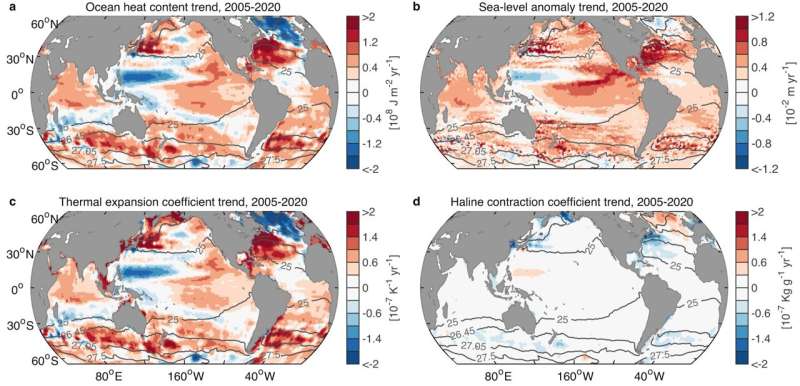This article has been reviewed according to Science X's editorial process and policies. Editors have highlighted the following attributes while ensuring the content's credibility:
fact-checked
peer-reviewed publication
trusted source
proofread
Ocean warming is accelerating, and hotspots reveal which areas are absorbing the most heat

Ocean warming has accelerated dramatically since the 1990s, nearly doubling during 2010–2020 relative to 1990–2000, according to new UNSW Sydney-led research.
The study, published in Nature Communications, also shows some areas of the ocean are doing more of the work in heat uptake or absorption, which has implications for our understanding of sea-level rise and climate impacts.
Increasing concentrations of greenhouse gases in the atmosphere from human activity traps heat within the climate system, warming air, the land surface, the oceans, and melting polar ice. Oceans do by far the most work, absorbing more than 90% of the excess human-generated heat accumulated in the Earth's climate system, moderating atmospheric temperature rises.
While ocean warming helps slow the pace of climate change, it is not without cost, says Scientia Professor Matthew England, co-author of the study from the UNSW Center for Marine Science and Innovation.
"The world ocean, in 2023, is now the hottest ever recorded, and sea levels are rising because heat causes water to expand and ice to melt," says Prof. England. "Ecosystems are also experiencing unprecedented heat stress, and the frequency and intensity of extreme weather events are changing rapidly, and the costs are enormous."
"Right now, the ocean is warming at a dramatically accelerating rate, nearly doubling during the 2010s relative to the 1990s," says Dr. Zhi Li, lead author of the study from the UNSW Center for Marine Science and Innovation. "What we wanted to do in this study was to figure out exactly where this ocean heat uptake has been occurring."
Hotspots of ocean heat uptake
For the study, the researchers evaluated all available observations of ocean warming activity spanning modern Argo float data—an international ocean research program that collects information using robotic instruments—to those taken in the 1950s when only sparse measurements were made from ship-borne devices. They then analyzed the heat uptake across water masses and quantified each water mass's role in ocean heat content change.
They found oceanic warming has been pervasive worldwide, spreading from the surface to the deep-sea regions known as the abyssal layers and spanning each basin from the tropics to the polar regions. However, the distribution of ocean warming by region was far from uniform.
The Southern Ocean saw the largest increase in heat storage over the past two decades, holding almost the same excess anthropogenic heat as the Atlantic, Pacific, and Indian Ocean combined. This includes two large masses of water in the Southern Ocean that combine to fill a depth range of 300–1,500 meters.
"Melting ice caps, extreme weather, and marine ecosystems, including coral reefs, are all highly sensitive to ocean temperature changes," says Dr. Sjoerd Groeskamp, co-author of the study from the Royal Netherlands Institute for Sea Research. "It is critical we understand exactly how and where the ocean warms—both now and into the future."
Exactly how heat uptake plays out over the coming decades and beyond remains highly uncertain. For example, if the oceans develop a reduced capacity to absorb heat, it will have profound implications for the rate of future climate change.
The scientists say their findings highlight an urgent need to increase monitoring of the global oceans, especially in remote locations like the polar oceans, as well as key regions of the subtropical and coastal seas to better understand and predict sea-level rise and impacts on marine ecosystems.
"Without Argo floats, for example, this study would not have been possible," says Prof. England.
The team also call for more international action from big-emitting nations to meet their net zero carbon targets as soon as possible and limit the damage from uncontrolled ocean warming.
"Without any action, these net zero pledges are just meaningless," says Dr. Groeskamp.
More information: Zhi Li et al, Recent acceleration in global ocean heat accumulation by mode and intermediate waters, Nature Communications (2023). DOI: 10.1038/s41467-023-42468-z
Journal information: Nature Communications
Provided by University of New South Wales




















